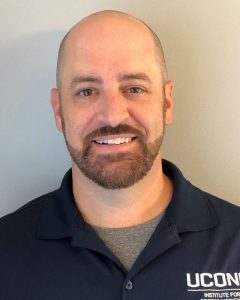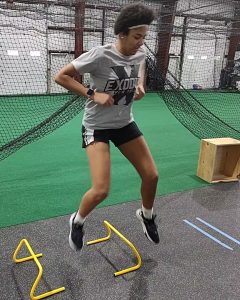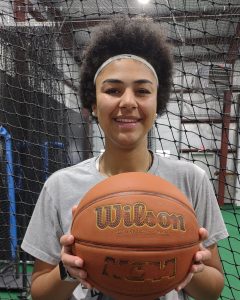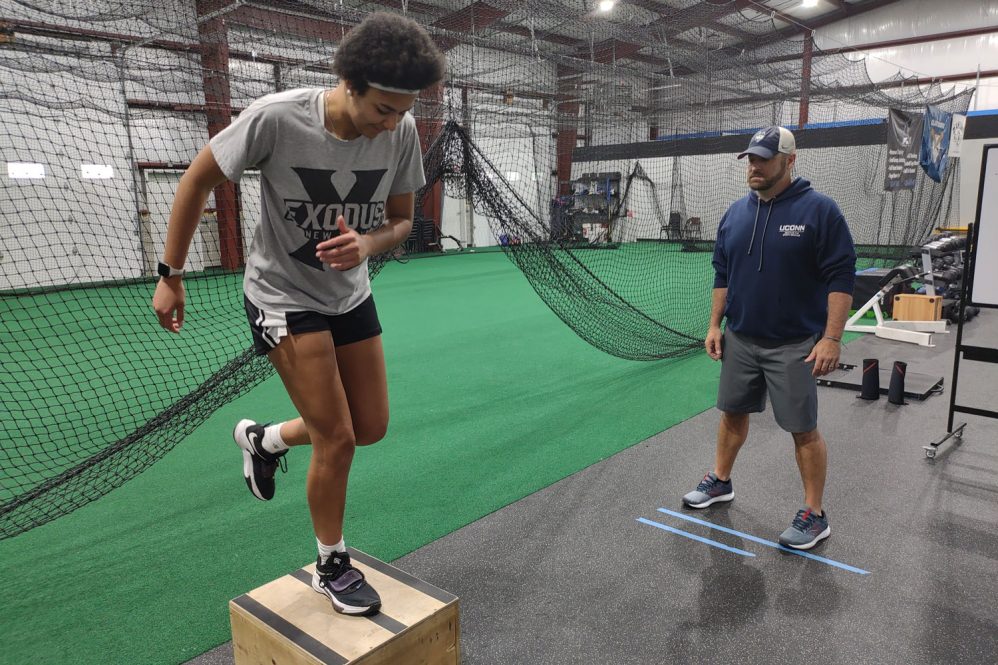Recovering from injury to resume normal day-to-day activities can be challenging enough. But what if “day-to-day” activities meant daily practice and a regular schedule of competition?
Injured athletes looking to return to their sports need to regain not only their function, but also their strength, agility, and quickness, plus motivation and confidence. In many cases that road back to play means learning new — and unlearning old — ways to move in order to reduce the chance of further injury while not being consumed by fear of additional injury.
That’s Michael DiStefano’s business. A certified athletic trainer, DiStefano is director of return to play and performance training at the UConn Institute for Sports Medicine. He also has a faculty appointment in UConn’s Department of Kinesiology.

“The vast majority of the people who I see are coming off of injuries such as ACL tears, repetitive ankle sprains or significant surgeries for the upper body or lower body,” DiStefano says. “I have others who’ll come in and see me after, for example, chronic knee pain, chronic low back pain, or maybe an Achilles tendon issue.”
He sees these athletes at a 6,000-square-foot indoor training center UConn leases in Glastonbury called The Apex.
“We try to figure out what is not working well within their body,” DiStefano says. “Are there muscle imbalances? Is there just lack of stability where there needs to be stability? Are they lacking of strength where they need it? My ultimate goal is to get them moving more efficiently and help prevent additional injuries and/or chronic pain.”
Most of the athletes DiStefano works with are between the ages 10 and 20, with the vast majority being high school student-athletes. He handles a range of situations, not limited to ACL recovery, although that is one of the most common injuries that brings these athletes to him.
“A large portion of my clients are recovering from ACL reconstructive surgery,” DiStefano says. “My goal is to be a part of their health care team when the time is right. I work with their physician and physical therapist to ensure a safe and effect return to sports/activities while minimizing their risk of additional injuries as best we can.”
Typically at around four months after the surgery, they’re ready to work with him two or three days a week.
“Usually when I see them at this point they’re maybe just starting to jog,” DiStefano says. “And then we’ll get them to the point where they’re ready to return to play. We work on performance training: power, speed, agility, and change of direction, both anticipated and unanticipated. My focus is to progress them safely while minimizing their risk of sustaining another injury, as best we can.”
One of the students who’s been working with DiStefano for several years now is Carys Baker, 18, who’s finishing her junior year at Loomis Chaffee High School in Windsor. She plays both basketball and volleyball.

Two years ago Baker tore the ACL in her left knee after a mid-air collision during a basketball game. She had torn the ACL in her right knee two years before that. In both cases, she went to UConn Health to have Dr. Cory Edgar surgically repair her knee, then worked with DiStefano on returning to play.
The second time came with an added wrinkle.
“I was out for about a year, because that was also when COVID was happening, so I had to do all of my strength training at home,” Baker says. “So Mike sent me a strength training program from email and we would do Zooms together because I couldn’t come [to the training center].”
She says in both cases, the addition of return-to-play training to the traditional physical therapy made a significant difference because it’s sport-focused.
“When I was going to just regular physical therapy, it was more just focusing on getting my mobility back, but here it’s more like, Mike gets me ready for basketball,” Baker says. “I wouldn’t be ready to be back on the court. I would be ready with my flexion and my extension, but my actual basketball playing and my lateral quickness, my defense, my shooting, even, wouldn’t be up to par where it should be. This is more important for learning how to not do things on the court that could probably make me get hurt again.”
Female athletes tend to be more susceptible to landing from jumps in a way that makes them more prone to ACL injuries, so part of Baker’s training was to adjust how she moves during competition.
“Mike also helped me get mentally ready to get back on the court, because I did express that I was nervous to go back after doing it twice,” she says. “I knew I was physically ready and he would always tell me that I was, but it was more just me being confident in my abilities, which was my fear after doing it twice.”

Baker says this past season, “I was perfectly fine on the court. It was just great to be back on the court.”
Now two years removed from surgery, Baker still comes to the training center to work with DiStefano. The focus now is on what she describes as a lingering hip issue.
She acknowledges there’s a chance she could get hurt again, just like any athlete in any competitive situation. Still, she says she’s confident when playing now.
“It’s honestly helped so much,” Baker says. “And coming back here, I’m so glad I got to come back here and work on my hip issues. Because I know I can still, even in the future, come back to Mike, and if I ever have any lingering issues again, come back here. But he’s helped me with the mental portion of that too so much.”
DiStefano joined UConn as an adjunct faculty member teaching strength training classes in 2014 while working for a physical therapy practice. Before the pandemic, he started his own business working with children and adults helping them return to their sports after injury. He joined UConn in his dual full-time role August 2021.
“Mike’s expertise in return-to-play programming allows us to bridge the gap between more typical injury rehabilitation and a comprehensive return-to-play strategy that begins early after an injury and culminates in evidence-based testing,” says Laurie Devaney, co-director of the UConn Institute for Sports Medicine. “This is key to a safe return to play and gives athletes the confidence to compete at their prior level.”
The UConn Institute for Sports Medicine works with high schools, colleges, and sports organizations spanning youth to professional, each with a unique relationship custom to its needs. Schools or programs looking to discuss partnering with the UConn Institute for Sports Medicine can email ism@uchc.edu.



